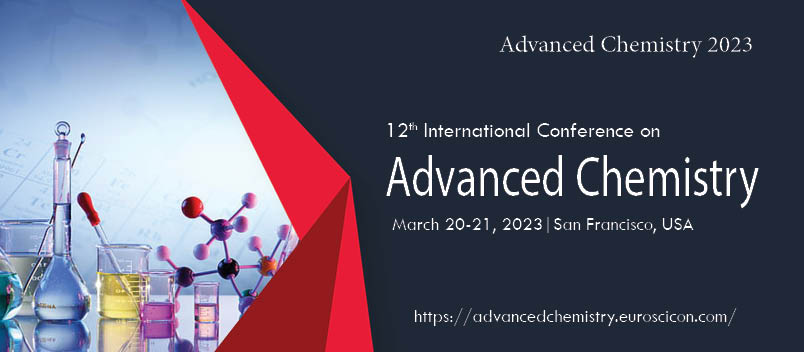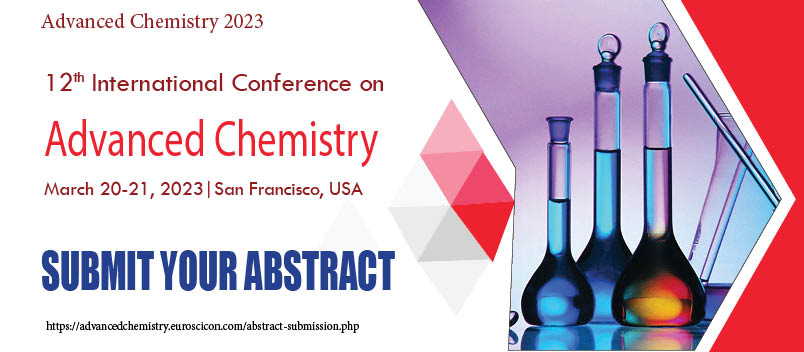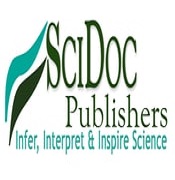ADVANCEDCHEMISTRY-2023
About Conference
We are happy to announce " 12th International Conference on Advanced Chemistry " scheduled during March 20-21, 2023 at San Francisco , USA with a theme of “Importance and Scope of Advanced Chemistry in the 21st Century”. We invite you all to Advanced Chemistry 2023 to have incredible associations with the professionals.
Advanced Chemistry-2023 assembles a wide range of scientific disciplines to discover, design, and delivery of new drugs and therapies. Chemistry Conferences is a worldwide stage to examine and find out about Advances in Organic Chemistry, Inorganic Chemistry, Materials Chemistry, Analytical Chemistry, Green Chemistry, Physical Chemistry, Biochemistry, Theoretical Chemistry, Scientific gatherings in the field of science.
Chemistry is the branch of Science that is involved in the study of composition, properties and reactivity of matter. Chemistry is called the central science because it is involved in every other science as a foundation, for example it is part of Botany as Plant chemistry; it is part of ecology as the formation of Ozone. Catalysis is a part of chemistry that deals with catalysts which accelerate the chemical reaction without being consume the catalyst can be recovered at the end chemical form unchanged.
There are five main divisions of chemistry, each of which is widely spread into many areas of study.
Analytical chemistry uses qualitative and quantitative observations to detect and measure the physical and chemical properties of a substance.
Physical chemistry combines chemistry with subject of physics. Physical chemists study how matter and energy interact with each other to form the result that they do. Thermodynamics and quantum mechanics are two of the important divisions of physical chemistry.
Organic chemistry specifically studies compounds that contain the element carbon and everything related to it. Carbon has many unique properties that allows it to form strong chemical bonds and very complex molecules. Organic chemistry is also known as the ‘Chemistry of Life’ because living tissues of the body have molecules which have carbon in them as a prime content.
Inorganic chemistry studies materials such as metals and gases that do not have carbon as a part of their component.
Biochemistry is the study of chemical processes that take place in living organisms.
The Global Chemistry Meetings would examine different themes identified with Biochemistry, Agricultural and Food Chemistry, Nuclear Chemistry, Polymer Chemistry, Stereochemistry, Forensic Chemistry, Medicinal and Pharmaceutical Chemistry, Industrial Chemistry and Environmental Chemistry.
Importance & Scope:
The main scope and importance of the conference is to bring all Professionals to one roof and share their experience in discussing the innovative trends in the field of Advanced Chemistry. This conference has taken the initiative to gather the world-class specialists both from academia and industry in a single platform. This conference will also helpful for the Young Researchers who are looking to grow in the field of Advanced Chemistry
Target Audience:
Analytical expertise researchers, Professors, Scientific communities, Delegates, Students, Business professionals and executives to attend the “12th International Conference on Advanced Chemistry” which is to be held during March 20-21, 2022 at San Fransisco, USA
Why to attend?
With members from around the world focused on learning about Chemistry, and applications, this is your best opportunity to reach the largest assemblage of participants. Conduct demonstrations, distribute information, meet with current and potential clients, make a splash with a new product line, and receive name recognition at this event. Also, you can have a great network with the eminent scientists in the field of Advanced Chemistry.
SESSIONS AND TRACKS
Track 1: Analytical and bio analytical Chemistry
The study of biochemical components present in a cell or other biological material is known as analytical biochemistry. Separation, quantification, identification and functional characterization of biological molecules are all methodologies used in this scientific area. These approaches are commonly used in biology for pharmaceutical product research, development, and quality control. There are two types of analytical chemistry methods: classical or wet chemical methods and modern, instrumental approaches
- Analytical Methods
- Analytical techniques for biological molecules
- Aptamer selection and utilization
- Bio analytical Methods
- Biosensors
- Chromatography
- Cloning, sequencing and mutagenesis
- Electrochemical methods
- Electrophoresis
- Enzyme characterization methods
- Immunological approaches
- Mass spectrometry of proteins and nucleic acids
- Metabolomics
- Nano level techniques
- Optical spectroscopy in all its form
Track 2: Medicinal Chemistry and Drug Discovery
Medicinal chemistry is the science of creating and synthesizing molecules with the goal of improving them and turning them into new drugs for treating diseases. It's an interdisciplinary field with roots in organic chemistry, biology, and pharmacology, among other areas. The chemical subject of medicinal chemistry, sometimes known as pharmaceutical chemistry, is concerned with the design, development, and synthesis of pharmaceutical medications. To identify, develop, and synthesize chemical agents with a therapeutic purpose, as well as to analyze the qualities of existing medications, the discipline integrates skills from chemistry and pharmacology.
- Developments in Medicinal Chemistry
- Rational Drug Design
- Docking
- Molecular Modeling
- Computational Studies
Track 3: Nano science and Materials Chemistry
Chemical substances or materials that are made and used on a very small scale are known as nanomaterials. Nano materials are created to have unique properties compared to materials that do not have Nano scale features, such as greater strength, chemical reactivity, or conductivity. Nanoparticles exist in nature and can be made from a range of materials, including carbon or minerals like silver, although nanomaterial must have at least one dimension of fewer than 100 nanometers by definition. The majority of Nano scale materials are too small to be seen with the naked eye or even with standard lab microscopes. Built nanomaterial’s (ENMs) are materials that have been engineered to such a small scale that they can take on unique optical, magnetic, electrical, and other properties. These emergent features have the potential to have huge implications in fields such as electronics, medicine, and others.
- Biomaterials
- Composites
- Degradation and Reliability
- Electronic, Magnetic and Semiconductor Materials
- Energy Materials
- Engineering and Functional Ceramics
- Green Materials
- Low D Materials
- Metallurgy
- Modeling of Materials
- Nano materials
- Optoelectronic Materials
- Specialty Polymers
- Surface Modification and Coatings
- Sustainable Materials
Track 4: Structural Chemistry
Structural chemistry is a branch of chemistry that studies the spatial structures of molecules and solids (in their gaseous, liquid, or solid states) (with extended structures that cannot be subdivided into molecules).
The major challenges are to (a) formulate basic laws for structure-property interactions and (b) derive general guidelines for how the chemical and physical properties of matter constituents determine the structures that result (e.g., the relationship between the symmetry of the resulting crystal lattice and the electron configuration of the crystal building blocks).
Track 5: Chemical Engineering
Chemical engineering is a branch of engineering that studies the operation and design of chemical facilities, as well as strategies for increasing output. Chemical engineers design cost-effective commercial techniques for transforming raw materials into usable goods. Chemists, physicists, mathematicians, biologists, and economists employ chemical engineering principles to efficiently use, create, design, transport, and transform energy and materials. Chemical engineers' work can span from small-scale laboratory experiments with nanotechnology and nanomaterial’s to large-scale industrial processes that convert chemicals, energy, raw materials, living cells and microbes into useful forms and products. Chemical engineers are in high demand due to the enormous number of sectors that rely on chemical and material synthesis and processing. Chemical engineers have increased prospects in pharmaceuticals, biotechnology, electronic device fabrication, and environmental engineering, in addition to traditional professions in the chemical, energy, and oil industries.
- Chemical Reaction Engineering
- Environmental Chemical Engineering
- Materials Synthesis and Processing.
- Separation Processes
- Advanced Oxidation Processes
- Adsorption of Contaminants
- Resources Recovery
- Waste-To-Energy
- Environmental Nanotechnology and Bioprocesses
- CO2 Capture and Utilization
- Micro (Nano) Plastic Detection and Remediation
Track 6: Future Scope of Chemistry
Chemistry is a branch of science that studies matter, its compositions, properties, and reactivity with other substances. The term "matter" refers to something that has mass and occupies space. Everything that is physically present around us is formed of matter. The foundation of matter, ranging from atoms, molecules, compounds, and measuring units of matter, is spelled out in Chemistry. Chemistry is a discipline that falls somewhere between many other branches of science in terms of its scope. This explains its significance in other fields of science. At a fundamental level, chemistry provides a framework for understanding both the fundamental and applied scientific fields.
We live in a world that is always changing and unpredictable. Traditional systems, structures, and ways of working have undergone significant changes as a result of technological, scientific, and societal advancements, and exciting new opportunities are developing. These developments are altering the nature of chemistry as a science, chemists' roles, and the environment in which we work.
Track 7: Catalysis and Reaction Engineering
Chemical reaction engineering has made a significant contribution to the commercialization of laboratory-developed chemistry. Reaction engineering can be used to analyze reactions, identify rate-limiting processes, calculate overall rates, choose reactor configurations, and design and scale-up reactors. Insights into catalytic cycles and clues for optimizing catalyst systems can also be gained through reaction engineering. Chemical reactions are fundamental to the transformation of molecules from basic materials to useful products and energy. Many of these changes rely on catalysis, which leads to more efficient and environmentally friendly processing methods. Catalysts are complicated materials that must meet a number of criteria on a variety of scales in order to be used in catalytic processes. For this, an integrated approach is needed, one that considers sustainability and scalability while combining modeling and experiments, catalysis science, and chemical engineering.
- Digitalization of chemistry
- Environment & climate
- New reaction development
- New synthesis technologies
- Pharmaceutical development
- Sustainable chemistry
Track 8: Biochemistry
The study of chemical processes within and pertaining to live beings is known as biochemistry or biological chemistry. Biochemistry is categorized into three fields: structural biology, enzymology, and metabolism. It is a sub-discipline of both chemistry and biology. Biochemistry has proven successful at understanding life processes through these three disciplines in the later decades of the twentieth century. Biochemical methods and study are being used to explore and develop almost every aspect of the biological sciences. Applied Biochemistry
- Biochemical Analyses
- Biological Chemistry
- Chemical Biology
- Chemical Composition of Living Matter
- Clinical Biochemistry
- Medical Biochemistry
Track 9: Organometallic Chemistry
Organometallic chemistry is defined as the scientific study of organometallic compounds, which are chemical compounds with at least one chemical bonding between a carbon atom of an organic molecule and a metal, such as alkali, alkaline earth, and transition metals, as well as metalloids such as boron, silicon, and selenium. Aside from connections to organyl fragments or molecules, organometallic linkages to 'inorganic' carbon, such as carbon monoxide (metal carbonyls), cyanide, or carbide, are also common. Organometallic compounds are widely used as stoichiometric catalysts in research and industrial chemical reactions, as well as in the role of catalysts to increase the rates of such reactions (e.g., in homogeneous catalysis), with target molecules including polymers, pharmaceuticals, and a wide range of other practical products.
Track 10: Electrochemistry
The study of electricity and how it affects chemical reactions is known as electrochemistry. Electricity is generated in electrochemistry by the passage of electrons from one element to another in a redox or oxidation-reduction reaction. The study of chemical reactions that cause electrons to move is known as electrochemistry. The movement of electrons is known as electricity, and it can be generated by moving electrons from one element to another in an oxidation-reduction ("redox") reaction. Electrochemistry is a truly multidisciplinary discipline with applications in a wide range of physical, chemical, and biological fields. Electrochemistry is a discipline and an industry based on physicochemical phenomena that occur when electrical and chemical energy exchanges collide in a reactive scheme.
- Batteries and power sources
- Bio electrochemistry
- Bio electrochemistry
- Computational and theoretical electrochemistry
- Electrochemical surface science
- Electrode reaction mechanisms
- Fundamental electrochemistry
- Organic and organometallic electrochemistry
- Properties of interfaces
- Spectro electrochemistry and sonoelectrochemistry
Track 11: Environmental and Green Chemistry
The study of reactions, origins, transport, effects, and the fates of all chemical species present in the soil, water, and air environments, as well as the influence of technology on them, is referred to as environmental chemistry. The scientific study of biochemical and chemical events that occur in natural settings is known as environmental chemistry. Environmental chemistry is a research field that encompasses more than just air, water, soil, and chemicals. This field employs a variety of methodologies from biology, arithmetic, genetics, engineering, hydrology, toxicology, and other fields to help find answers to all environmental concerns. Environmental chemistry encompasses features of analytical chemistry, physical chemistry, organic chemistry, and inorganic chemistry, as well as a wide range of other disciplines such as epidemiology, public health, biochemistry, biology, and toxicology. Environmental chemists are in charge of figuring out how the unpolluted environment works and developing environmentally friendly methods of development.
- Environmental Chemistry
- Environmental Toxicology
- Pollution and Remediation
- Environmentally Friendly Synthetic Pathways
- Alternative Fuels
- Ecotoxicology and Risk Assessment
- Environmental Processes and Modeling
- Environmental Technologies
Track 12: Forensic and Clinical Chemistry
The term "forensic" comes from the Latin word "forensis," which refers to a public forum or discussion. The application of chemistry and its subspecialty, forensic toxicology, in a legal situation is known as forensic chemistry. Unknown materials collected at a crime scene can be identified with the help of a forensic scientist. To help identify unknown compounds, experts in this discipline use a variety of methodologies and devices. Investigators can use forensic chemists' analyses to get answers and validate or disprove their assumptions. The identification of the numerous compounds discovered at the site can help investigators figure out what they should be looking for during their search.
Clinical chemistry (sometimes referred to as chemical pathology, clinical biochemistry, or medical biochemistry) is a branch of chemistry that deals with the examination of body fluids for diagnostic and therapeutic purposes. It is a type of biochemistry that is employed in practice.
- Chemo metrics And Statistics
- Drug Analysis
- Electrochemical Techniques
- Explosives Detection and Analysis
- Forensic Toxicology
- Gunshot Residue Analysis
- Ignitable Liquid Residue Analysis
- Ink and Paper Analysis
- Mass Spectrometry
- Molecular and Atomic Spectrochemical Technique
- Nuclear Magnetic Resonance
- Sensors, Surface Characterization Techniques
- Separation Sciences
- Synthetic Pathways for Drugs
- Trace Evidence
Track 13: Marine and Geo Chemistry
Plate tectonics and seafloor spreading, turbidity currents, sediments, pH levels, atmospheric elements, metamorphic activity, and ecology all influence ocean chemistry, also known as marine chemistry. Chemical oceanography is the study of the chemistry of marine habitats, including the effects of various variables. Marine ecosystems are sensitive to changes in ocean chemistry, and marine life has evolved to the chemistries specific to the earth's seas. Human activity has had a growing impact on the chemistry of the earth's oceans, with pollution from industry and diverse land-use patterns having a considerable impact on the oceans.
Geochemistry is a field of Earth Science that uses chemical principles to learn more about the Earth system and other planets' systems. Geochemists see the Earth as a collection of separate spheres — rocks, fluids, gases, and biological — that exchange matter and energy throughout time. The study of the processes that influence the amount, composition, and distribution of chemical compounds and isotopes in geologic environments is also known as geochemistry. In terms of the themes it covers and the methodologies it employs, geochemistry is a vast and intriguing discipline.
- Inorganic and organic carbon study
- Archaeometry
- Cosmo chemistry, Meteoritics
- Environmental Geosciences
- Experimental - Theoretical - Field Related Studies
- Igneous, Metamorphic, And Sedimentary Petrology
- Low & High Temperature Geochemistry
- Mineralogy - Crystallography
- Nutrients Study
- Trace Elements Study
- Volcanology
Track 14: Industrial Chemistry
Industrial chemistry is a discipline of chemistry that involves the use of physical and chemical processes to turn raw materials into products that benefit humanity. This covers the production of basic chemicals for use in a variety of industries. Industrial chemistry can be defined as a field that creates synthetic alternatives to natural products. The chemical industry is made up of businesses that make industrial chemicals. It turns basic materials (oil, natural gas, air, water, metals, and minerals) into over 70,000 different products, making it a vital part of the modern world economy. Industrial chemistry is a discipline of chemistry concerned with the use of chemistry in various industries and the manufacturing of chemicals and pharmaceuticals.
Track 15: Nutrition and Food chemistry
Food chemistry is the study of all biological and non-biological components of foods' chemical processes and interactions. Meat, poultry, vegetables, beer, and milk are just a few examples of biological materials. It comprises areas like as water, vitamins, minerals, enzymes, food additives, flavors, and colours, and is comparable to biochemistry in terms of its main components such as carbohydrates, lipids, and protein. This field also includes how products change as a result of various food processing procedures, as well as ways to improve or prevent this from happening. Food chemistry is concerned with the chemical structure and properties of food constituents, as well as the chemical changes that occur in food. The ability of food chemistry to counteract the effects of disintegration and spoilage, as well as extend the shelf life of foods, is crucial. Various household compounds, such as common salt in pickles, chutneys, and sauces, aid in food preservation.
- Bioactive constituents of foods
- Chemical and biochemical composition and structure
- Chemistry relating to major and minor components of food
- Chemistry of food additives
Track 16: Organic and Inorganic chemistry
Organic chemistry is the study of carbon-containing molecules' structure, characteristics, composition, reactions, and manufacture. The most common elements in organic compounds are carbon and hydrogen, although they can also contain a variety of other elements (e.g., nitrogen, oxygen, halogens, phosphorus, silicon, sulphur). Organic chemistry is a very creative science in which chemists are able to develop and investigate molecules and compounds..
The study of the synthesis and behaviour of inorganic and organometallic compounds is known as inorganic chemistry. This topic encompasses non-carbon-based chemical substances, which are the focus of organic chemistry. The distinction between the two fields is not absolute, as the sub discipline of organometallic chemistry has a lot of overlap. The behaviour of these molecules, as well as their qualities, physical and chemical characteristics, are studied in inorganic chemistry. Lists of inorganic compounds include all elements of the periodic table except carbon and hydrogen.
- Organic Industrial Chemistry
- Organic compounds
- Natural products
- Development of synthetic methodologies
- Catalysis
- Organic synthesis
- Functional organic materials
- Supra molecular and macromolecular chemistry
- Physical and computational organic chemistry
- Coordination and Organometallic Chemistry
- Bioinorganic Chemistry
- Solid State, Materials, and Nano scale Chemistry
- Energy and Photochemistry
- Catalysis
Track 17: Petrochemistry
The scientific world is divided into numerous domains, each with its own set of traits and goals. Petrochemistry is one of the most significant branches, although its long name often causes confusion. Simply put, Petrochemistry is a discipline of chemistry concerned with the transformation of crude oil and natural gas into raw materials and other valuable products. Such resources are now considered an essential component of the modern economy, making Petrochemistry a highly valued topic. It's crucial to grasp what petroleum is and where it comes from before diving into the topic of Petrochemistry. Natural changes in organic materials have formed petroleum, which has accumulated beneath the earth's surface over millions of years. Petroleum-rich places are typically found in settings where retention is possible, such as porous sandstones.
- Chemical engineering
- Drilling & well operations
- Earth or Environmental Sciences
- Enhanced oil and gas recovery
- Hydrogeology
- Marine and Petroleum Geology
- Mineralogy
- New Technologies and Discoveries
- Oceanography
- Oil and gas engineering
- Petrochemical processes
- Petrochemical Refining Processes
- Petroleum economy
- Petroleum engineering & technology
- Separation process
- Unconventional oil resources
Track 18: Physical Chemistry and Theoretical Chemistry
Physical chemists study the physical properties of atoms and molecules, as well as the mechanisms behind chemical processes and what these properties disclose. Physical chemistry is a discipline of chemistry that deals with material interactions and changes. Unlike other divisions, it focuses on the physics principles that underpin all chemical interactions (e.g., gas laws), with the goal of quantifying, correlating, and explaining response quantitative features. Physical chemistry is a great field for chemists who are interested in how things work at the atomic level and appreciate working with lab equipment and machines.
The study of theoretical chemistry uses quantum mechanics, classical mechanics, and statistical mechanics to explain the structures and dynamics of chemical systems, as well as to correlate, interpret, and forecast their thermodynamic and kinetic properties. The study of chemical structure and the study of chemical dynamics are generally divided in modern theoretical chemistry.
- Bio-Physical Chemistry
- Catalysis
- Chemical Kinetics
- Colloid Chemistry
- Dynamics
- Electrochemistry
- Kinetics
- Micrometrics
- Photochemistry
- Quantum Chemistry
- Quantum Mechanics
- Solid State Chemistry
- Spectroscopy
- Statistical Mechanics
- Surface Chemistry
- Surface Science
- Surface Structural Chemistry
- Theoretical Developments
- Thermodynamics
- X-Ray Crystallography
Track 19: Polymer Chemistry
Polymer chemistry is a branch of science that studies polymers and macromolecules' chemical production, structure, and chemical and physical properties. Polymer chemistry principles and methods can be used to a variety of other chemistry sub-disciplines such as organic chemistry, analytical chemistry, and physical chemistry. Polymeric structures can be found in a wide range of materials, from totally inorganic metals and ceramics to DNA and other biological molecules; nevertheless, polymer chemistry is most commonly associated with synthetic, organic compositions. Polymer chemistry opens up a fascinating universe of structures with a variety of architectures, compositions, and functions. As polymer chemistry progresses, many of the opportunities and problems that lie ahead will revolve around the assembling or production of higher-order objects.
- Physical Characterization
- Polymer Engineering
- Polymer Materials
- Polymer membranes for separation technology
- Polymer Synthesis, Modification and Self-assembly
- Polymers for energy generation and storage
- Polymers for opto- and microelectronics
Track 20: Natural Products Chemistry
A natural product, in the broadest sense, is anything that is produced by life, including biotic materials (such as wood and silk), bio-based materials (such as bio plastics and corn starch), bodily fluids (such as milk and plant exudates), and other natural materials that were once found in living organisms (e.g., soil, coal). Any organic substance generated by a living organism is a more stringent definition of a natural product. Natural goods have a high structural diversity and distinctive pharmacological or biological actions as a result of hundreds of thousands of years of natural selection and evolutionary processes that have influenced their utility. Analytical Characterization of Natural Products
Track 21: Emerging technology on Supramolecular and Surface chemistry
Supramolecular chemistry deals with "ordered entities that come from the association of two or more chemical species held together by intermolecular forces" and is defined as "the chemistry of molecular assemblies and of the intermolecular link." Supramolecular chemistry is the branch of chemistry that studies chemical systems with a finite number of molecules. The forces responsible for the system's spatial organization can range from mild intermolecular forces, electrostatic charge, or hydrogen bonding to strong covalent bonding, as long as the electronic coupling strength is moderate in comparison to the component's energy parameters. Noncovalent interactions between small molecules are used in supramolecular chemistry to self-assemble molecular structures.
Surface chemistry is the discipline of chemistry that studies chemical reactions and changes that occur at the interface of two phases, such as solid – gas, solid – liquid, liquid – gas, and so on. Surface chemistry has a wide range of applications in analytical work, medicine, and the paint industry, to name a few.
- Biological Supramolecular chemistry
- Dynamic combinatorial chemistry
- Metal-ligand assemblies
- Metallocycles and metallocages
- Molecular machines and motors
- Molecular sensors (chemosensors)
- Nanoreactors and nanocarriers
- Semiconductor’s functionalization
- Supramolecular catalysts
- Supramolecular polymers
- Surface reactivity
Track 22: Chemistry of Transition Elements
Transition metals are described as elements with partially full d orbitals (or that readily form them). The d-block (groups 3–11) and f-block element elements are among them. Transition metals have a wide range of properties due to their complicated valence shells. Unlike most main group metals, which only have one oxidation state, transition metals have a valence shell structure that allows them to exist in multiple stable oxidation states. Compounds contain lots of transition elements are known for being brightly coloured. The d-orbitals absorb light of various energies as visible light passes through a transition metal complex dissolved in water. A clearly coloured solution is produced when visible light of a certain energy level is not absorbed.
Track 23: Challenges and Opportunities in CADD
Computational techniques are used in computer-aided drug design to find, develop, and study drugs and other physiologically active compounds. The ligand-based computer-aided drug discovery (LB-CADD) method examines ligands that have been shown to interact with a target of interest. Computer-aided drug design (CADD) is a broad term that refers to a variety of theoretical and computational methodologies used in modern drug development. CADD approaches have aided in the creation of medications that are currently in use or are through clinical testing. Along with the experimental procedures employed in drug creation, such methods have emerged and evolved. Millions of drug compounds (virtual screening) and drug targets (protein receptors, enzymes, kinases, signaling proteins, and so on) can be screened using CADD.
- Bioinformatics of Drug Molecules and Databases
- Biomarkers
- Biomedical Instrumentation
- Biosensors
- Drug Delivery Systems
- Drug Intermediates
- Lipase- And Esterase-Mediated Drugs
- Pharmacokinetics and Pharmacodynamics
- Robotics in Medicine
Track 24: Pharmaceutical Chemistry
Pharmaceutical chemistry is a field of chemistry that studies organic chemistry (molecules and compounds) in conjunction with structural and chemical biology and pharmacology in order to develop pharmaceutical drugs and therapies. The design (drug design) and synthesis of physiologically active compounds is the focus of pharmaceutical (medicinal) chemistry. The goal is to obtain new chemical molecules that can be used to find new pharmaceuticals or to improve existing drug structures, hence expanding the chemical drug portfolio. The introduction of molecular biology changed pharmacokinetics (the study of how a drug and its metabolites behave in the body) and pharmacodynamics (the study of how a drug and its metabolites behave in the body). The development of computer techniques and approaches in molecular modeling approaches, as well as advances in analytical evaluation of new molecules, have all considerably broadened the reach and use of pharmaceutical chemistry, allowing for the development of a wider array of innovative drugs with new therapeutic potential.
- Drug Discovery
- Methods of Industrial Production
- Methods of Synthesis
- Pharmacodynamics
- Pharmacokinetics
- Pharmacological Study
- Pharmacology
- Toxicological and Biochemical Studies
Track 25: Green and Environmental Chemistry
Environmental chemistry is associated with the impact of polluting chemicals on the natural resources, green or sustainable chemistry focuses on the impact of environmental factors or attributes with respect to chemistry, reduction in the consumption of conventional resources and technological solutions for preventing pollution.
Both the concepts are different from each other
Green chemistry, also termed as sustainable chemistry is that branch of chemical sciences that emphasizes on design of chemical processes and products that minimize generation of hazardous chemical substances.
Environmental chemistry is the branch of science that involves the study of biochemical processes that occur in nature. It involves the understanding of how the uncontaminated environment works, and which naturally occurring chemicals are present, in what concentrations and with what effects.
Track 26: Pure and Applied Chemistry
Pure chemistry is the study of what something is, while applied chemistry is the application of that knowledge to a specific aim. The fundamentals of chemistry are pure chemistry and organic chemistry. Only knowing why or what something is more important than knowing what you can do with it. Pure chemistry is concerned with the question of "why is this that way" or "how does this operate," and seeks to answer it.
Applied chemistry is a branch of science concerned with understanding the fundamental chemical properties of materials and developing novel materials with precise uses. The practice of applying past knowledge to attain a goal is known as applied chemistry. Consider applied chemistry as the study and application of information with the objective of assisting (or potentially harming) people or the environment.
- Advances in chemical analysis
- Bioavailability
- Chemical synthesis and properties
- Chemicals and biological matters
- Chemistry and biomaterials
- Chemistry and industry
- Electrochemistry and biosensors
- Instrumentation
- Nano materials and Nano systems
- Organometallic compounds and complexes
- Polymer synthesis and properties
- Relationships between chemistry and environment and chemicals and medicine, Soil and plant chemistry
- Speciation
- Supramolecular and Macromolecular chemistry
- Theoretical chemistry
Track 27: Nuclear and Radio Chemistry
Nuclear Chemistry and radiochemistry is a broad field, with applications and applications in a wide range of fields. Nuclear chemistry is a branch of chemistry that studies how elements' nuclei change over time. Radioactivity and nuclear power are produced by these changes. Because radioactivity is linked to nuclear power generation, the disposal of radioactive waste that goes along with it, and some medical procedures, everyone should have a basic understanding of radioactivity and nuclear evolutions in order to determine and discuss the issue wisely and effectively.
The study of chemical transformations of radioactive substances, dealing with trans uranium and actinides elements, solving radioecology problems, development of physicochemical principles for handling radioactive waste from nuclear power engineering, developing methods for manufacturing sources of radioactive emissions, and separation of radioactive isotopes are all part of the field of radiochemistry. “Radiation chemistry” is concerned with the study of chemical transformations caused by ionizing radiation, as well as the study of radiation-chemical processes, the development of methods for predicting the radiation resistance of various materials, and the development of methods to protect them from destruction.
- Environmental radiochemistry
- Nuclear fuel chemistry
- Nuclear instrumentation and automation
- Nuclear power plant chemistry
- Production and control of radioisotopes and labelled compounds
- Radiation chemistry
- Radiation detection and measurement
- Radio analytical chemistry
- Radiobiological chemistry
Track 28: Agricultural Chemistry
Agricultural chemistry is a branch of science that studies how to impact chemical and biochemical processes in soil and plants, as well as plant mineral nutrition and the use of fertilizers and other chemical methods to boost fertility and yield. It also covers a variety of different methods for increasing production, such as herbicides and growth stimulants, and serves as the scientific foundation for introducing chemical processes into agriculture. Agricultural chemistry shares goals, techniques, and research issues with both chemical and biological sciences. The relation between plants, animals, and the environment is stressed in agricultural chemistry in order to better the agricultural sector. A biochemist uses strategies to improve the production, protection, and use of animals and crops using their knowledge of biochemistry.
- Agricultural Bioresource Technology
- Agricultural Chemistry
- Agricultural Composting
- Agricultural Environment
- Agricultural Microbiology
- Agrochemicals
- Soil-Plant relation
Track 29: Synthetic Chemistry
Organic, inorganic, materials, and even biological sciences are all covered under synthetic chemistry. Chemical synthesis makes use of the elements' intrinsic reactivity to build increasingly sophisticated molecular architectures by carefully executing chemical reactions. Synthesis-trained chemists employ their skills to produce new types of matter. Synthetic chemistry is the study of the relationship between organic molecule structure and reactivity. In pharmaceutical research and development, chemical synthesis is crucial.
- Bioactive natural products
- Catalysis
- Inorganic materials
- Inorganic metal complexes
- Metal organic frameworks
- Nano materials
- New reaction development
- Organic materials
- Organometallic reagents
- Polymers
- Quantum materials
Track 30: Chemistry in Clinical Research
Clinical chemistry (sometimes referred to as chemical pathology, clinical biochemistry, or medical biochemistry) is a branch of chemistry that deals with the examination of body fluids for diagnostic and therapeutic purposes. It is a type of biochemistry that is employed in practice. The biochemical analysis of body fluids is referred to as clinical chemistry. It determines the amounts of various chemical components in physiological fluids through chemical processes. Different molecules in blood and urine, the most often examined specimens in clinical chemistry, are detected and quantified using a variety of simple chemical tests.
Track 31: Technological advancement in Organic Synthesis
Organic synthesis is a subset of chemical synthesis that deals with the deliberate creation of organic molecules. Organic molecules are frequently more complicated than inorganic compounds, and their synthesis has evolved into one of organic chemistry's most important disciplines. Within the broad field of organic synthesis, there are several major research areas. Organic synthesis entails one or more stages for manufacturing chemicals from easily available starting components. Designing synthetic paths to a molecule is at the heart of organic synthesis.
- Chemo selectivity
- Methodology and Applications
- Stereo selective Synthesis
- Synthesis Design
- Total Synthesis
MARKET ANALYSIS
Synopsis:
The global chemical laboratory market is predicted to increase at a CAGR of 5.2 percent from $87.96 billion in 2020 to $92.55 billion in 2021. At an annual growth rate of 8%, the market is estimated to reach $123.83 billion in 2025. Region/country wise chemical market report is available at advanced chemistry-2023
MARKET ANALYSIS
The development of the world’s largest chemical market China features a vital impact on the world rate of growth. We tend to once more expect slightly stronger growth here once a relatively weak figure in 2020. As a result, China can presumptively all over again account for pretty much 2 proportion points of world chemical growth. Growth rates within the staying rising markets of Asia ought to remain stable. In contrast, chemical growth within the US ought to obtain. One reason for the upper growth forecast for 2022 is that the production outages within the US caused by cyclone doc in fall 2021. Additionally, new production capacities can reach the market in 2022, which is able to presumptively increase exports further. We tend to expect growth within the E.U. to stay on top of average in 2018, however slower than in 2021. Domestic demand in key client industries can in all probability be slightly weaker following sturdy industrial growth within the previous year. We tend to conjointly anticipate weaker export demand from Asia.
Chemistry is a broad, diverse and multidisciplinary field. It is continuous interaction with basic disciplines and is also contributing to meet all Grand Societal Challenges. Chemistry is the study of how matter comports on a molecular and atomic level and how chemical reactions occur. Chemistry blends the principles of physics and chemistry to study the physical characteristics, or properties, of molecules. By understanding these properties, you learn more about the way in which molecules are put together, as well as how the genuine structure of a chemical is impacted by these properties.
The meeting will be a multidisciplinary gathering and present major areas such as organic, inorganic, forensic, nuclear chemistry
and their policies. The forum of Scientists, students and researchers from all corners of the globe, come together to discuss future of chemistry science. Each session of the meeting will be included with expert lectures, poster and discussions, join us to design sustainable processes, innovations by which and how these strategies drive new policies, advances the business and human health protection. We are glad to invite you on behalf of organizing committee to join us, where you are the decision maker for future.
Market Value on Chemistry Research: -
The overall flow chemistry market share is majorly propelled by numerous value added advantages offered by the process as compared to batch reactors. The process offers low capital and maintenance cost, minimum raw material requirement, which subsequently results in reduced operational cost. Furthermore, it also provides efficient & easy reactants mixing, superior heat & mass transfer along with enhanced reaction control. These process characteristics are analyzed to positively impact on the global industry growth over the estimated period.
Global fine chemicals market is expected to witness a steady growth during the forecast period, this growth of global fine chemicals market is expected to be driven by growth of the major end use industries. Adapting and accepting flow chemistry process and technology will help the chemical manufacturing companies to reduce these toxic gases and thereby will boost the global flow chemistry market size by 2024. Pharmaceuticals and agrochemicals, being major consumers of fine chemicals, the growth in these industries is in turn expected to fuel the growth of global fine chemicals market during the forecast period. Moreover, growing demand from developing countries, especially those in Asia Pacific, is expected to result in growth of global fine chemicals market. A major trend witnessed in global fine chemicals market is that the companies producing fine chemicals are channelizing efforts towards development of efficient processes and newer products in order to gain a competitive advantage which eventually translates into a higher share in global fine chemicals market.
- Pharmaceutical
- Chemical
- Academic & industrial research
- Petrochemical
- Others
Market Growth of Chemistry Research in the last and upcoming ten years:
The global clinical chemistry analyzers market was estimated at $8,965 million in 2014. This market is expected to grow at a CAGR of 5.52% between 2014 and 2019, to reach $11,728.01 million in 2019. Global chemical production (excluding pharmaceuticals) will probably grow by 3.4% in 2017, the same pace as 2016 (+3.4%). We anticipate a marginally higher expansion rate in the advanced economies (2016: +0.9%, 2017: +1.1%). Growth in the emerging markets will presumably weaken somewhat (2016: +5.4%, 2017: +5.1%). The global clinical chemistry analyzers market was estimated at $8,965 million in 2014. This market is expected to grow at a CAGR of 5.52% between 2014 and 2019, to reach $11,728.01 million in 2019.
Funds allotted to Chemistry and Chemical Companies: -
The world’s 50 largest chemical corporations control a global market valued at $697 billion in 2009. Dow Chemicals and many other chemical companies around the world provide strong industry exposure for investors, including Germany's BASF, China's Sinopec, Saudi Basic Industries Corporation and the Swiss company Ineos. These companies are among the largest producers of chemical products, and chemical manufacturing is either very significant or an exclusive part of their business models.
At long last, industry (from little new businesses to vast universal partnerships) gives a significant part of the rest of, which give both to graduate research assistantships and support for students leading exploration on a venture.
Apart from the industrial personnel where most of the research work is done, other research communities include:-
Academicians include Student community.
Researchers include Post docs, Research Associates.
Scientists include Professors, Associate professors, and Assistant professor.
Industries include Presidents, CEO’s, and R&D Managers.
- The global adhesive and adhesive-applying equipment market should reach $74.5 billion by 2022 from $57.8 billion in 2017 at a compound annual growth rate (CAGR) of 5.2%, from 2017 to 2022.
- The global market volume for refinery catalysts should reach 2,234.3 metric kilotons by 2021 from 2,019 metric kilotons in 2016 at a compound annual growth rate (CAGR) of 2.0%, from 2016 to 2021. The global market for oilfield process chemicals should reach $29.6 billion by 2021 from $26.9 billion in 2016 at a compound annual growth rate (CAGR) of 2%, from 2016 to 2021
- The global consumption of flame retardant chemicals reached nearly 5.4 billion pounds in 2016. The market should reach 5.6 billion pounds in 2017 and 7.3 billion pounds by 2022, growing at a compound annual growth rate (CAGR) of 5.4%, from 2017 to 2022.
- The global agrochemical market should reach $266.0 billion by 2021 from $213.2 billion in 2016 at a compound annual growth rate (CAGR) of 4.5%, from 2016 to 2021.
- The U.S. market for fluorochemical and polymers is expected to increase from 2.1 billion pounds in 2016 to nearly 2.4 billion pounds in 2021 at a compound annual growth rate (CAGR) of 2.3% for 2016-2021. The alternative U.S chemical end-use product market is expected to increase from $149.9 billion in 2016 to an estimated $345.6 billion by 2021. It should reach $884.1 billion by 2026, with a compound annual growth rate (CAGR) of 19.4% for the period of 2016-2026.
Today, many materials chemists are synthesizing functional device materials, and the discipline is often seen as directed towards producing materials with function—electrical, optical, or magnetic. Material Chemistry is involved in the designing and processing of materials. Global market for catalysts is expected to reach $28.5 billion by 2020, growing at a CAGR (2015 to 2020) of over 3%. Asia-Pacific is having the largest market for catalysts accounting for more than 35% share.
The global market for CNT primary grades was $158.6 million in 2014. This market is projected to reach $167.9 million in 2015 and $670.6 million in 2019, with a compound annual growth rate (CAGR) of 33.4% from 2014 to 2019. The global market for nanotechnology products was valued at $22.9 billion in 2013 and increased to about $26 billion in 2014. This market is expected to reach about $64.2 billion by 2019, a compound annual growth rate (CAGR) of 19.8% from 2014 to 201
Global Advanced Chemistry Market:
· Lucintel’s market reports provide quantitative and qualitative data analysis for the global and regional markets. These industry reports study annual trends; provide forecast statistics; detail the industry’s drivers and challenges; discuss growth challenges at various levels. The global overactive bladder treatment market is projected to reach USD 4.19 Billion by 2022 from USD 3.63 Billion in 2017, at a CAGR of 2.9%. The key players in the global overactive bladder treatment market are Astellas Pharma, Inc. (Japan), Pfizer, Inc. (U.S.), Allergan, Plc. (Ireland), Teva Pharmaceutical Industries Limited (Israel), Mylan N.V. (U.S.), Medtronic plc (Ireland), Endo International plc (Ireland), Sanofi (France), Hisamitsu Pharmaceutical Co., Inc. (Japan), Aurobindo Pharma Limited (India), Apotex Inc. (Canada), and Cogentix Medical, Inc. (U.S.). The global market volume for refinery catalysts should reach 2,234.3 metric kilotons by 2021 from 2,019 metric kilotons in 2016 at a compound annual growth rate (CAGR) of 2.0%, from 2016 to 2021. The global market for oilfield process chemicals should reach $29.6 billion by 2021 from $26.9 billion in 2016 at a compound annual growth rate (CAGR) of 2%, from 2016 to 2021.
The global analytical standards market is projected to reach USD 1.73 Billion by 2022 from USD 1.27 Billion in 2017, at a CAGR of 6.3%. The process analytical technology (PAT) market is poised to reach USD 3.30 Billion by 2021 from USD 1.77 Billion in 2016, at a CAGR of 13.3% from 2016 to 2021. The global process analytical technology market is segmented on the basis of technique, measurement, products and services, end user, and region. On the basis of technique, the process analytical technology market is segmented into spectroscopy, chromatography, particle size analysis, capillary electrophoresis, and other techniques (calorimetry, thermal analysis, total organic carbon analysis, and FIA).
The global pharmaceutical packaging equipment market is estimated to grow at a CAGR of 6.8% from 2017 to 2022 to reach USD 8.24 Billion approximately by 2022. The growth of the market can be attributed to factors such as cost containment in pharma R&D, growth in funding for generics and biopharmaceutical research, and technological advancements in labeling and serializations solutions. The development of production lines for small batch size and research purposes, growing focus of pharmaceutical manufacturers to cut operational costs, and rising emphasis on labeling and serialization for anti-counterfeiting of drugs are the key trends in the market.
The global nuclear energy demand exceeded 2,400 TWh in 2014 and it is estimated to grow at a CAGR of over 4% from 2015 to 2022. Nuclear energy accounted over 11% of the global energy generation in 2014. Increasing power and energy demand from households and industrial sectors is expected to fuel market growth over the forecast period.
The global PET preforms market was at USD 17.14 Billion in 2016 and is projected to reach USD 23.35 Billion by 2022, at a CAGR of 5.31% from 2017 to 2022. Key companies profiled in the global PET preforms market research report include Retal Industries Ltd. (Cyprus), Plastipak Holdings, Inc. (US), RESILUX NV (Belgium), ALPLA Werke Alwin Lehner GmbH & Co KG (Austria), Zhuhai Zhongfu Enterprise Co. Limited (China), Society General Techniques (France), Indorama Ventures Public Company Limited (Thailand), KOKSAN Pet Packaging Industry Co. (Turkey), Taiwan Hon Chuan Enterprise Co., Ltd (Taiwan), and Rawasy Al Khaleej Plastic Ind. (UAE).
The precious metal catalysts market size is estimated to grow from USD 14.37 Billion in 2017 to USD 19.41 Billion by 2022, at a CAGR of 6.19%. The base year considered for the study is 2016, and the market size is projected from 2017 to 2022. The major players in the precious metal catalysts market include BASF SE (Germany), Evonik Industries AG (Germany), Johnson Matthey Plc (U.K.), Heraeus Group (U.K.), Clariant International Ltd (Switzerland), Umicore SA (Belgium), Alfa Aesar (U.S.), and Vineeth Precious Catalysts Pvt. Ltd. (India).
The global adhesive and adhesive-applying equipment market should reach $74.5 billion by 2022 from $57.8 billion in 2017 at a compound annual growth rate (CAGR) of 5.2%, from 2017 to 2022.The industrial gases was valued at $66.7 billion in 2014. The market is expected to grow from $68.7 billion in 2015 to $80.9 billion in 2020, a compound annual growth rate (CAGR) of 3.3% from 2015 to 2020.













